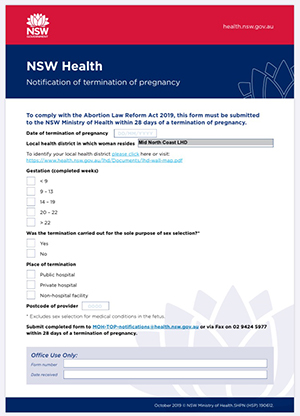In a “Dear Doctor” letter to the state’s medical practitioners the NSW Health Secretary Elizabeth Koff has advised that the Abortion Law Reform Act 2019, passed on 2 October after criticism by objecting MPs and their supporters, means that terminations are now legal but must be reported within 28 days of the procedure.
The single-page notification form requires information on the LHD in which the woman resides, the gestation of the foetus - ranging from under 9 weeks to 22 weeks, after which special conditions apply - where the termination took place (public or private hospital, or non-hospital facility), the postcode of the provider, and perhaps more controversially, whether the termination was carried out “for the sole purpose of sex selection”, unless the foetus had medical conditions.
During the acrimonious debates that preceded the bill’s passing a number of critics suggested that certain ethnic communities preferred male children and would seek to abort girls.
The Act repeals the provisions of the Crimes Act 1900 relating to termination of pregnancy and abolishes the attendant common law offences. Getting it through NSW State parliament was one of the most divisive political events of recent times.
Health Secretary Koff told practitioners the Act establishes a health centered approach for termination of pregnancy, supports a woman's right to health, including reproductive health and autonomy, and provides clarity and safety for registered health practitioners providing terminations of pregnancy.
“The Act enables a medical practitioner to perform a termination up to 22 weeks, provided informed consent has been obtained. After 22 weeks, except in emergencies, only a specialist medical practitioner can perform a termination.
“There are additional requirements in the Act relating to terminations after 22 weeks, including that a termination of pregnancy on a person who is more than 22 weeks pregnant must, except in an emergency, be performed in certain public hospitals or other facilities approved by the Health Secretary.”
Further information is available from Tish Bruce, Executive Director, Health and Social Policy,
















